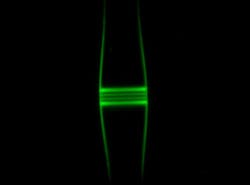TU Vienna develops single-atom fiber-optic switch
Vienna, Austria--Building on earlier research that showed light oscillation in the longitudinal direction within an optical fiber, a Physical Review Letters paper from the Vienna University of Technology (TU Vienna) describes how the researchers have used a single atom to build a fiber-optic switch at the smallest possible scale in order to manipulate light. Conventional glass optical fiber cables for communications can now be interconnected by tiny quantum systems.
Professor Arno Rauschenbeutel and his team at TU Vienna capture light in so-called "bottle resonators". At the surface of these bulgy glass objects, light runs in circles. If such a resonator is brought into the vicinity of a glass fiber that is carrying light, the two systems couple and light can cross over from the optical fiber into the bottle resonator. “When the circumference of the resonator matches the wavelength of the light, we can make one hundred percent of the light from the glass fibre go into the bottle resonator—and from there it can move on into a second glass fibre”, explains Rauschenbeutel.
This system, consisting of the incoming fiber, the resonator, and the outgoing fiber, is extremely sensitive: "When we take a single Rubidium atom and bring it into contact with the resonator, the behaviour of the system can change dramatically," says Rauschenbeutel. If the light is in resonance with the atom, it is even possible to keep all the light in the original glass fiber, and none of it transfers to the bottle resonator and the outgoing glass fiber. The atom thus acts as a switch which redirects light into one or the other optical fiber.
In the next step, the scientists plan to make use of the fact that the Rubidium atom can occupy different quantum states, only one of which interacts with the resonator. If the atom occupies the non-interacting quantum state, the light behaves as if the atom was not there. Thus, depending on the quantum state of the atom, light is sent into either of the two glass fibers. This opens up the possibility to exploit some of the most remarkable properties of quantum mechanics: "In quantum physics, objects can occupy different states at the same time," says Rauschenbeutel. The atom can be prepared in such a way that it occupies both switch states at once. As a consequence, the states 'light' and 'no light' are simultaneously present in each of the two glass fiber cables.
For the classical light switch at home, this would be plain impossible, but for a 'quantum light switch', occupying both states at once is not a problem. "It will be exciting to test, whether such superpositions are also possible with stronger light pulses. Somewhere we are bound to encounter a crossover between quantum physics and classical physics," says Rauschenbeutel.
This light switch is a very powerful new tool for quantum information and quantum communication. "We are planning to deterministically create quantum entanglement between light and matter," says Rauschenbeutel. "For that, we will no longer need any exotic machinery which is only found in laboratories. Instead, we can now do it with conventional glass fibre cables which are available everywhere."
SOURCE: TU Vienna; http://www.tuwien.ac.at/en/news/news_detail/article/8480/

Gail Overton | Senior Editor (2004-2020)
Gail has more than 30 years of engineering, marketing, product management, and editorial experience in the photonics and optical communications industry. Before joining the staff at Laser Focus World in 2004, she held many product management and product marketing roles in the fiber-optics industry, most notably at Hughes (El Segundo, CA), GTE Labs (Waltham, MA), Corning (Corning, NY), Photon Kinetics (Beaverton, OR), and Newport Corporation (Irvine, CA). During her marketing career, Gail published articles in WDM Solutions and Sensors magazine and traveled internationally to conduct product and sales training. Gail received her BS degree in physics, with an emphasis in optics, from San Diego State University in San Diego, CA in May 1986.
